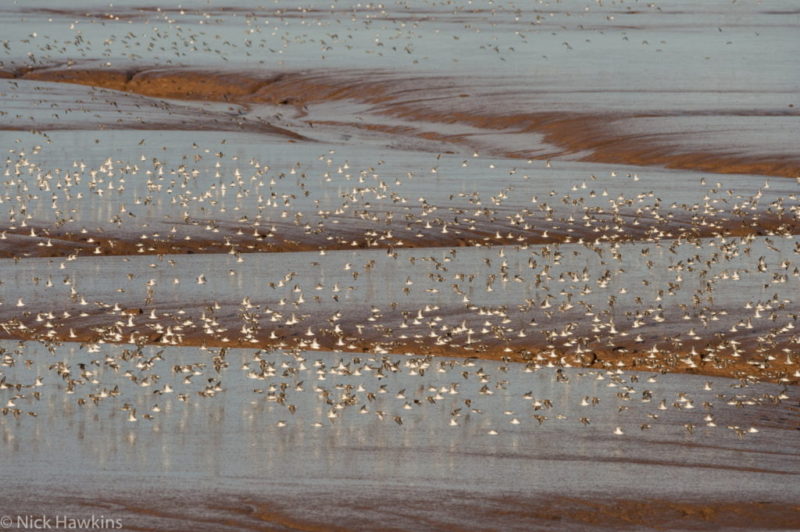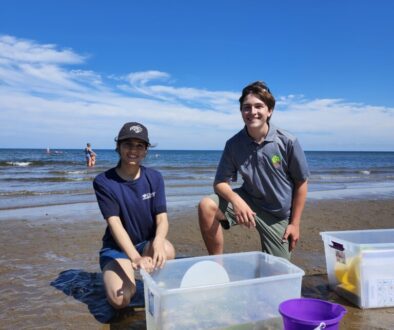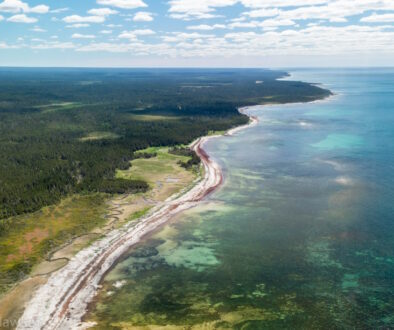Exploring New Brunswick’s beachside habitats
What do you think of when you hear the word “habitat”? Do you think of the forest? Of the Ocean? Of the faraway deserts, grasslands, or frozen tundra? All these large areas are important habitats for many different kinds of plants and animals, but habitats don’t have to be classified so generally. The only requirement for an area to be considered as habitat is that it has enough space, food, shelter, and water to entirely support at least one plant, animal, or other organism throughout its life.
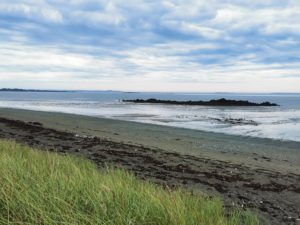
Habitats can be as big as a forest or as small as a single dead tree that is home to many insects who can find everything they need to live within its trunk. That same tree might be only a part of the habitat needed to support a bird that nests in the tree. The bird finds shelter in the tree, but ultimately depends on a much larger section of the forest to find food, water, and mates. Different species have their own unique habitat requirements. Some species are “habitat generalists” and can survive in a variety of places, while others are very specific in their needs.
Many types of coastal creatures are “habitat specialists”, who have strong preferences for temperatures, exposure to air, level of salt in the water, and more. When we protect habitats, it is so important to include these seaside spaces that are home to specialist species. Some of these habitats you might see every time you visit the beach, but have not reflected on their purpose or importance to many types of shoreline plants, animals, birds, and more. Let’s explore three types of shoreline habitats that can be found from the beaches of New Brunswick!
1. Intertidal Zone
The intertidal zone is a big habitat, made up of other smaller habitats, that you have probably walked over many times, especially if you have ever visited the Bay of Fundy. Our special Bay has the highest tides in the world and therefore the world’s largest intertidal zone! The intertidal zone is what you might think of as the seashore. At low tide, its rocky or sandy surface is exposed to the air and, in most cases, walkable by beach goers. It’s where you go to do some beachcombing, looking for shells and sea glass. At high tide, the intertidal zone is covered in water and becomes part of the ocean again! To humans who can only survive on land, or fish that can only survive underwater, living in the intertidal zone would be impossible. For many ocean species who are unable to travel to deeper water, but require access to the ocean to eat or breathe, the intertidal zone is the perfect habitat.
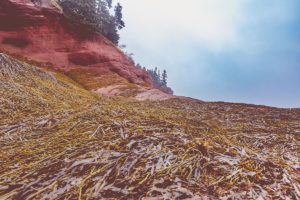
Shelled species like crabs, limpets, and snails are well suited to the upper areas of the intertidal zone, where the water is shallowest at high tide. While the water is covering their habitat, they can hunt and move freely without fear of large, deep water predators. Then, when the water has retreated, they can hide beneath rocks or seaweed and rely on their shells for protection from inland predators. Further down the tidal zone, immobile marine animals like barnacles and mussels, who need water to breath, can fill their shells with water while the tide is up and enjoy a few hours of relief from aquatic predators while the water is down. Similarly, many types of seaweeds and algae that grow in the intertidal zone have adapted ways of surviving while exposed to the air. Some of these plants can lose 60-90% of their moisture while the tide is low, becoming quite brittle in the hours before the ocean rises when they can reabsorb all the moisture they need to survive. When it comes to the intertidal zone, there is always more than meets the eye! Next time you visit the beach, keep your eyes alert for the many species that call the beach home while your stroll.
2. Mudflats
Mudflats are exactly what they sound like: muddy, flat areas near the edge of the ocean that are saturated with both salt and freshwater. They are a part of the intertidal zone, but species that rely on sand or rock cover cannot survive in their sticky depths. They form in inlets or bays that are sheltered from larger waterways or harsh storms that wash sediment away from beaches. Sediment and dirt accumulate over time in these areas, building up to create, sometimes quite deep, stretches of mud. Mudflats might look void of life, but they are actually teeming with coastal species!
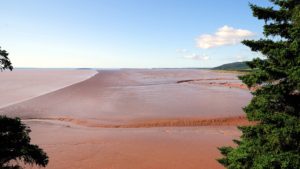
Species that can survive where oxygen is limited, like clams, mud shrimps, worms, and insects, live beneath the surface in mudflats. Many types of shoreline birds feed on these species, with legs and feet specially adapted to walk on or through the dense surface and beaks able to penetrate the mud. Mudflats are also the perfect habitat for many different types of bacteria, all of which have different and important roles in the ecosystem. Some bacteria break down plant matter into a form that smaller coastal animals can easily eat, while others break down contaminants in runoff from land-based water, which would otherwise reach the ocean.
Despite their empty looking appearance, mudflats are an incredibly important habitat, and one that has often been neglected or threatened by development. Next time you see a stretch of mud at the beach, imagine the many species who depend on this habitat to survive!
Virtually explore New Brunswick’s mudflats here!
3. Kelp Forests
Kelp forests are not as easily seen while walking along the beach. This habitat exists underwater, in shallow areas along the coast where sunlight can still penetrate the water to allow for photosynthesis, the process in which kelp and other plants create the food they need to survive. Since kelp need cool temperatures to grow, many patches of kelp forest can be found in the cold ocean waters of New Brunswick. A variety of New Brunswick marine animals depend on these aquatic forests for their habitat.
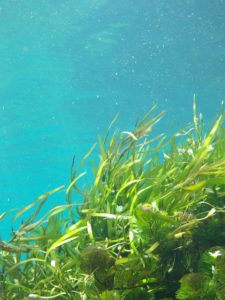 Some small crustaceans, like crabs, and invertebrates, like sea stars, can spend their entire lives in kelp forests, feeding on algae or their fellow inhabitants, and using the kelp as shelter from predators. Kelp forests are frequented by species of worms, snails, plankton, small shrimps, anemones, and jellyfish, and many larger sea and land animals rely on kelp forests as a component of their habitat. Fish, like cod and haddock, seals, and many types of seabirds can be spotted searching for food, hiding from predators, and seeking shelter from storms in these patches of algae.
Some small crustaceans, like crabs, and invertebrates, like sea stars, can spend their entire lives in kelp forests, feeding on algae or their fellow inhabitants, and using the kelp as shelter from predators. Kelp forests are frequented by species of worms, snails, plankton, small shrimps, anemones, and jellyfish, and many larger sea and land animals rely on kelp forests as a component of their habitat. Fish, like cod and haddock, seals, and many types of seabirds can be spotted searching for food, hiding from predators, and seeking shelter from storms in these patches of algae.
As climate breakdown progresses, kelp are threatened by warming waters. Kelp forests in our region are deteriorating, as threats from human activities and stressors accumulate. It is important to protect existing pockets of this important habitat now, while we work to preserve ocean conditions that will allow new forests to emerge and thrive!
For a little more information about life among the kelp, check this out.
For many of us, when we think of a day at the beach we picture sandy toes, salty hair, and the sounds of joy as we soak in a dose of Vitamin N (for Nature). What we might not think of is the diversity of habitats, and the species they contain, that call our beaches home. The next time you visit a favourite New Brunswick beach or picturesque coastal town, look to where the land meets the water and remember the important habitats and ecosystems living just below the surface. What might be out of sight, doesn’t have to be out of mind, and we at CPAWS-NB are working hard to ensure these habitats are protected now and into the future.
Support the work of CPAWS-NB with a donation today!
Sandpipers in Johnson’s Mills, Bay of Fundy, header photo by Nick Hawkins

Maddie Carr is a third-year student at the University of New Brunswick pursuing a major in Interdisciplinary Leadership Studies and a minor in Environmental Studies. She is currently a Conservation Outreach Assistant with CPAWS NB. The opportunities she has received here to expand her knowledge on the importance of protecting and appreciating natural areas is preparing her for her future goals of supporting conservation work in the environmental non-profit sector. Maddie firmly believes that those who experience nature want to protect it, which is why she spends a lot of time exploring wild areas like New Brunswick’s parks and encourages others to do the same!

